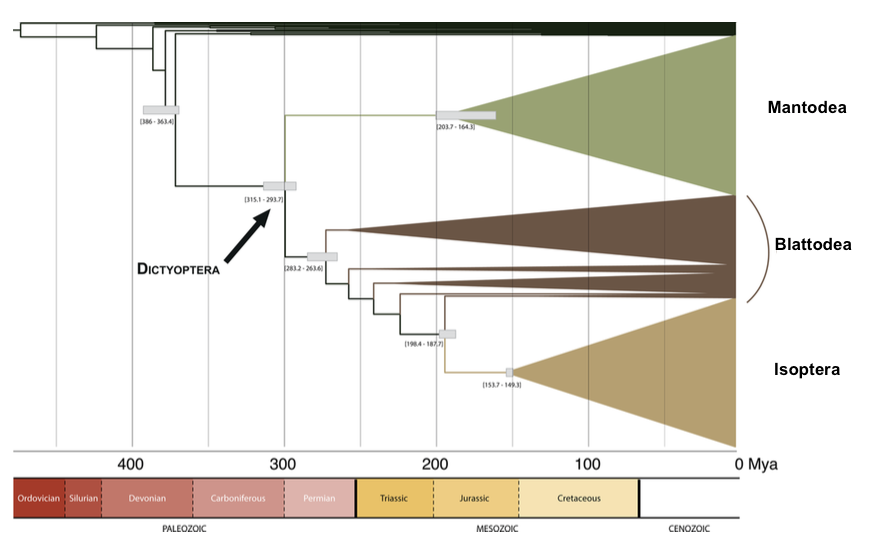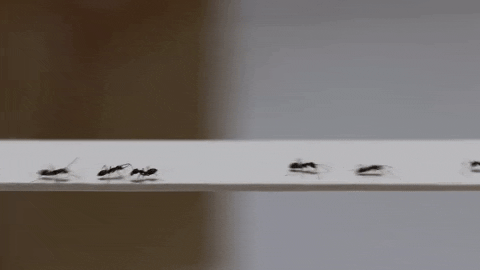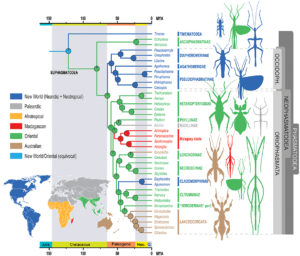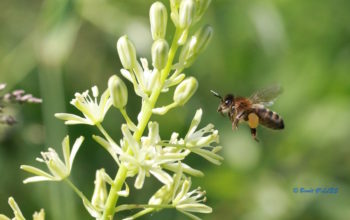Cockroaches, termites and mantis, despite obvious morphological and behavioural differences, share a common ancestor and belong to the order Dictyoptera. The small quantity of fossils available and their little exploitable state, make the understanding of their evolutionary history difficult and complex. Many uncertainties and controversies remain regarding the phylogeny of the different families and their place in the classification.
This is why a team of scientists, led by Frédéric Legendre of the Muséum National d’Histoire Naturelle de Paris (MNHN), undertook studies based on both molecular and fossil analyses in order to clarify the history of these evolutionary events to provide new data. Their results show that the first Dictyoptera appeared in the Paleozoic, during the Carboniferous/Permian period, 310 million years ago. The cockroach taxon, long considered to be the oldest of the three, is in fact more recent (-275 million years ago), secondarily appearing from that of the mantis-religious (-300 million years ago). Finally, the appearance of termites would go back to the Jurassic/Cretaceous limit (-150 million years), refuting the hypothesis of an appearance in the Triassic (-250 million years).
The phylogeny is the science of kinship between present and fossil species: it allows us to trace the history of evolutionary events in the living world. Understanding the origin and diversification of organisms during evolution requires possession of very rich fossil records.
caption id=”attachment_2314″ align=”alignright” width=”279″] Photo 1 : Cretaceous fossil cockroach (-125 million years) (Source : China – Liaoning Province – Fossilmuseum.net)[/caption]
Photo 1 : Cretaceous fossil cockroach (-125 million years) (Source : China – Liaoning Province – Fossilmuseum.net)[/caption]
In insects, phylogenetic studies are particularly difficult because of rare, limited and, most of the time, not very exploitable fossil archives (Photo 1). To fill this gap, scientists are using molecular and genetic analyses of current species which, combined with fossil, morphological and environmental data, make it possible to determine their relationship.
Frédéric Legendre’s team was interested in the order Dictyoptera, which includes cockroaches (suborder Blattodea), termites (suborder Isoptera) and mant-religious (suborder Mantodea) whose evolutionary history remains controversial.
Their study consisted in analyzing and comparing DNA samples from 800 taxa, representing a wide range of current diversity, calibrated with fossil data at clear synapomorphs (character present in two species and inherited from a common ancestor).
The results of their study, published on July 22, 2015, bring a new look at <!more–>the evolution of these insects, as well as the development of social behaviours and symbiotic digestive and intracellular relationships ( see figure 1 at the bottom of the page) (For more information on symbiotic relationships in social insects: read th article).
Since the 19th century, the suborder of cockroaches has been considered the oldest of the Dictyoptera by the presence of numerous Paleozoic and Mesozoic fossils. The hypothesis proposes that cockroaches are ancestral forms of termites and mantis religions, a hypothesis based on morphological characteristics: an ovipositor (laying organ) present in fossil forms and absent in contemporary species, and by other morphological features on wings and mouth parts, although difficult to interpret. The MNHN team shows that cockroaches did not appear during the Devonian (-400 million years), but more recently, during the Permian (-275 million years).
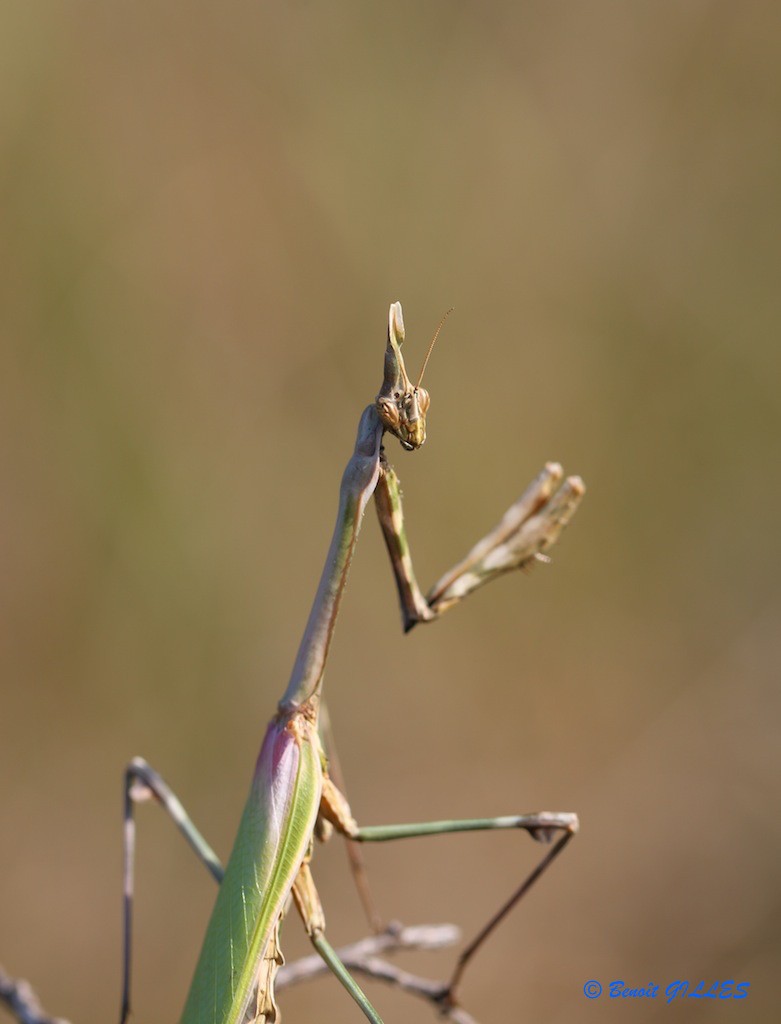
The appearance of the mantis-religious (photo 2), considered as posterior to cockroaches and termites, is in fact much earlier and earlier than these two groups. Scientists indeed set the emergence of the first ancestors of the mantises at around -300 million years (late Triassic-early Jurassic) and then diversify to -185 million years. This estimate seems consistent with the recent discovery of new fossils.
Termites, on the other hand, would have appeared more recently, around -150 million years ago (Jurassic-Cretaceous limit), refuting the idea of an appearance in the Triassic (-250, -200 million years), hypothesis proposed by Hasiotis & Dubiel (1995) following the discovery of “termite mounds” dated to the end of the Triassic (-215 million years). Studies have recently shown that these fossil nests did not allow to conclude the presence of termites at this period because they could be built by other arthropods. Termites, having been the first insects to develop eusociality (animal society where individuals are grouped into castes, where reproduction is restricted to a few individuals and where at least two adult generations co-exist taking care of the young), other types of fossils, such as sterile workers or suture marks on the chest caused by the loss of wings following the reproduction of a queen, could constitute better evidence.
This study raises questions
- Knowing the major role of termites in ecosystems as decomposers of organic matter, one may wonder how warm ecosystems functioned before they appeared. What organizations played this role at the Trias, for example? The same question arises concerning coprophages ( which feed on faecal matter ), a role currently played by various Beetles and Diptera (flies), groups of insects that appeared more recently in the Cenozoic.
Scientists once suggested that the first Dictyoptera were detritus feeders (cockroaches and termites) and that during evolution, the ancestors of the mantis-religious would have acquired a carnivorous diet.
Or, this study suggests that evolutionary events are reversed. Originally, the Dictyoptera were carnivorous insects as confirmed by the age of the mantises. During evolution, new adaptations have led to the appearance of cockroaches at first and termites more recently.
Many shadow areas remain, however. Future research will need to answer these questions and clarify chronological events using complementary phylogenetic and fossil data.
caption id=”attachment_2307″ align=”aligncenter” width=”617″] Illustration 1 : Simplified phylogenetic tree of the order Dictyoptera (Source : Legendre et al., 2015 – Modified by B. GILLES)[/caption]
Illustration 1 : Simplified phylogenetic tree of the order Dictyoptera (Source : Legendre et al., 2015 – Modified by B. GILLES)[/caption]
Source :
– Legendre F. et al., (2015) : Phylogeny of Dictyoptera : Dating the origin of cockroaches, praying mantises and termites with molecular data and controlled fossil evidence. PLOS One, 10(7) – Original article to read here

